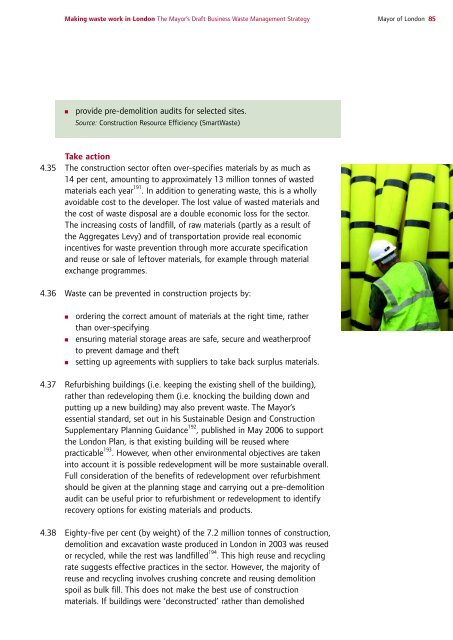Draft Business Waste Strategy PDF - london.gov.uk - Greater ...
Draft Business Waste Strategy PDF - london.gov.uk - Greater ...
Draft Business Waste Strategy PDF - london.gov.uk - Greater ...
You also want an ePaper? Increase the reach of your titles
YUMPU automatically turns print PDFs into web optimized ePapers that Google loves.
Making waste work in London The Mayor’s <strong>Draft</strong> <strong>Business</strong> <strong>Waste</strong> Management <strong>Strategy</strong> Mayor of London 85<br />
■ provide pre-demolition audits for selected sites.<br />
Source: Construction Resource Efficiency (Smart<strong>Waste</strong>)<br />
Take action<br />
4.35 The construction sector often over-specifies materials by as much as<br />
14 per cent, amounting to approximately 13 million tonnes of wasted<br />
materials each year 191 . In addition to generating waste, this is a wholly<br />
avoidable cost to the developer. The lost value of wasted materials and<br />
the cost of waste disposal are a double economic loss for the sector.<br />
The increasing costs of landfill, of raw materials (partly as a result of<br />
the Aggregates Levy) and of transportation provide real economic<br />
incentives for waste prevention through more accurate specification<br />
and reuse or sale of leftover materials, for example through material<br />
exchange programmes.<br />
4.36 <strong>Waste</strong> can be prevented in construction projects by:<br />
■ ordering the correct amount of materials at the right time, rather<br />
than over-specifying<br />
■ ensuring material storage areas are safe, secure and weatherproof<br />
to prevent damage and theft<br />
■ setting up agreements with suppliers to take back surplus materials.<br />
4.37 Refurbishing buildings (i.e. keeping the existing shell of the building),<br />
rather than redeveloping them (i.e. knocking the building down and<br />
putting up a new building) may also prevent waste. The Mayor’s<br />
essential standard, set out in his Sustainable Design and Construction<br />
Supplementary Planning Guidance 192 , published in May 2006 to support<br />
the London Plan, is that existing building will be reused where<br />
practicable 193 . However, when other environmental objectives are taken<br />
into account it is possible redevelopment will be more sustainable overall.<br />
Full consideration of the benefits of redevelopment over refurbishment<br />
should be given at the planning stage and carrying out a pre-demolition<br />
audit can be useful prior to refurbishment or redevelopment to identify<br />
recovery options for existing materials and products.<br />
4.38 Eighty-five per cent (by weight) of the 7.2 million tonnes of construction,<br />
demolition and excavation waste produced in London in 2003 was reused<br />
or recycled, while the rest was landfilled 194 . This high reuse and recycling<br />
rate suggests effective practices in the sector. However, the majority of<br />
reuse and recycling involves crushing concrete and reusing demolition<br />
spoil as bulk fill. This does not make the best use of construction<br />
materials. If buildings were ‘deconstructed’ rather than demolished
















